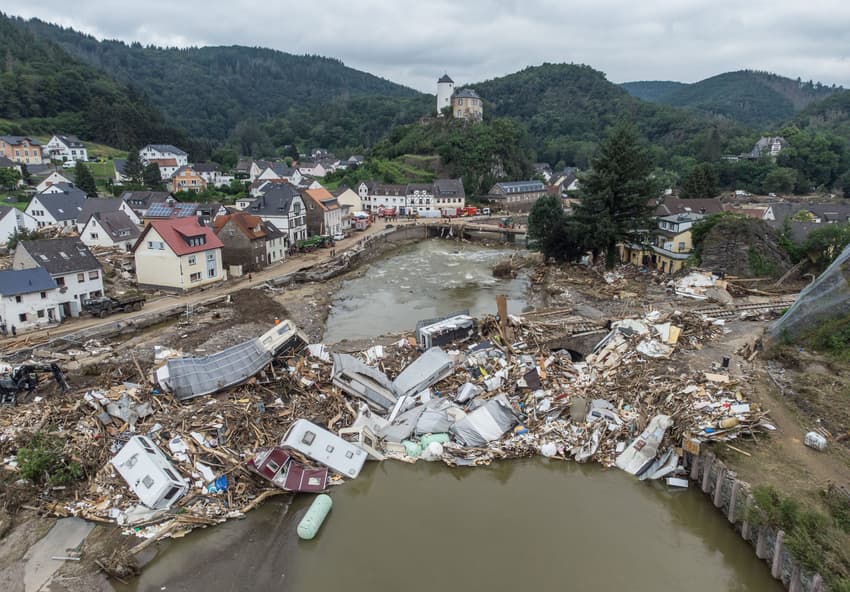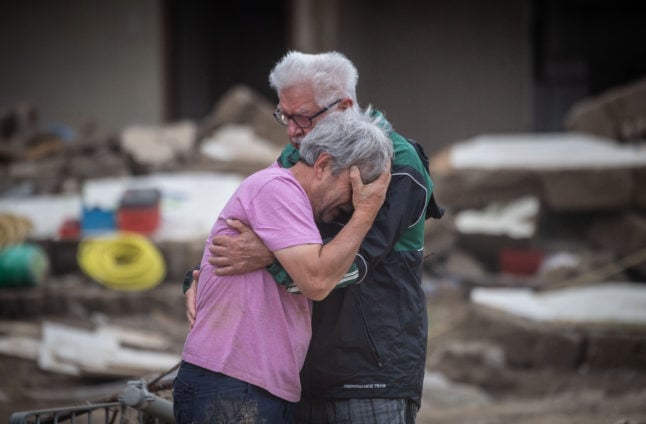How flash floods left a trail of destruction in western Germany

The dramatic floods of July 14th and 15th, 2021 killed more than 220 people in Europe, leaving a trail of destruction in Germany and Belgium, and damage in the Netherlands, Austria and Switzerland. We looked back at the devastating natural disaster.
A heavy toll
After two days of torrential rain, flood waters carried away nearly everything in their path, devastating entire communities.
Western Germany was hit worst by the flooding. The state of Rhineland-Palatinate registered 49 deaths, while North Rhine-Westphalia said 135 were killed. One person died in Bavaria and in all, over 800 were injured.
The total cost of the damage in Germany is estimated to be more than €30 billion.
The floods destroyed railways, roads, bridges, electricity pylons and mobile towers, as well as disrupting the supply of gas, electricity and water in a number of places.
Across the two worst-hit regions, 85,000 households were affected and some 10,000 businesses impacted.
READ ALSO: Flood anniversary prompts sadness and soul searching in Germany
In the east of Belgium, 39 people lost their lives in the high waters. The Wallonia region was particularly badly affected, with some 100,000 people caught up in the catastrophe and 48,000 buildings damaged.
Climate extremes
In the 24 hours before the floods, the Ahr valley in Germany saw more than 90 litres (24 gallons) of rain per square metre, while the average for the entire month of July is just 70 litres.
The magnitude of the downpour broke records for Germany since meteorological records began.
Other factors contributed to make the floods worse. After a rainy spring, the earth was already well saturated with water.

Brothers Bernd and Gerd Gasper hold each other in front of their flood-damaged parent's house in Altenahr-Altenstadt a few days after the flood disaster. Photo: picture alliance/dpa | Boris Roessler
At the same time, the region's steep, narrow valleys channelled the flood waters, while the impermeability of the developed land along the river's edge stopped much of it from draining away.
IN PICTURES: The aftermath of Germany’s catastrophic floods
Experts have pointed to the influence of man-made climate change, which increases the likelihood of extreme weather events. A warmer atmosphere can hold more water, leading to higher rainfall in shorter spaces of time.
A month after the floods, an international scientific study using statistical models showed the link between global warming and the recent catastrophe.
In the affected zone, stretching from Belgium to Switzerland, they demonstrated that the maximum precipitation had increased by between three to 19 percent due to climate change.
READ ALSO: More floods, droughts and heatwaves: How climate change will impact Germany
Missing alarm
Since the catastrophe, a number of failures in the early-warning system have come to light.
Six days before the disaster on July 8th, the European warning system flagged a high risk of flooding in the region.
The German meteorological service and civil defence also put out warnings.
But these failed to be heeded.
READ ALSO: Germany knew its disaster warning system wasn't good enough - why wasn't it improved?
Residents "got the impression it was about heavy rain" but the "magnitude was not signalled" clearly enough, a German official said after the floods.
A criminal inquiry was opened for "negligent homicide", targeting the Ahrweiler district chief, among others.
The German government now intends to send alerts by phone, a system known as "cell broadcasting".
Similar to a text message, the warning is sent to the mobile phones of people in at-risk areas. Unlike a normal text, the alert is sent and received even when the network is overloaded.
Officials also want to reinstall sirens, many of which were taken down in recent years.
Comments
See Also
A heavy toll
After two days of torrential rain, flood waters carried away nearly everything in their path, devastating entire communities.
Western Germany was hit worst by the flooding. The state of Rhineland-Palatinate registered 49 deaths, while North Rhine-Westphalia said 135 were killed. One person died in Bavaria and in all, over 800 were injured.
The total cost of the damage in Germany is estimated to be more than €30 billion.
The floods destroyed railways, roads, bridges, electricity pylons and mobile towers, as well as disrupting the supply of gas, electricity and water in a number of places.
Across the two worst-hit regions, 85,000 households were affected and some 10,000 businesses impacted.
READ ALSO: Flood anniversary prompts sadness and soul searching in Germany
In the east of Belgium, 39 people lost their lives in the high waters. The Wallonia region was particularly badly affected, with some 100,000 people caught up in the catastrophe and 48,000 buildings damaged.
Climate extremes
In the 24 hours before the floods, the Ahr valley in Germany saw more than 90 litres (24 gallons) of rain per square metre, while the average for the entire month of July is just 70 litres.
The magnitude of the downpour broke records for Germany since meteorological records began.
Other factors contributed to make the floods worse. After a rainy spring, the earth was already well saturated with water.

At the same time, the region's steep, narrow valleys channelled the flood waters, while the impermeability of the developed land along the river's edge stopped much of it from draining away.
IN PICTURES: The aftermath of Germany’s catastrophic floods
Experts have pointed to the influence of man-made climate change, which increases the likelihood of extreme weather events. A warmer atmosphere can hold more water, leading to higher rainfall in shorter spaces of time.
A month after the floods, an international scientific study using statistical models showed the link between global warming and the recent catastrophe.
In the affected zone, stretching from Belgium to Switzerland, they demonstrated that the maximum precipitation had increased by between three to 19 percent due to climate change.
READ ALSO: More floods, droughts and heatwaves: How climate change will impact Germany
Missing alarm
Since the catastrophe, a number of failures in the early-warning system have come to light.
Six days before the disaster on July 8th, the European warning system flagged a high risk of flooding in the region.
The German meteorological service and civil defence also put out warnings.
But these failed to be heeded.
READ ALSO: Germany knew its disaster warning system wasn't good enough - why wasn't it improved?
Residents "got the impression it was about heavy rain" but the "magnitude was not signalled" clearly enough, a German official said after the floods.
A criminal inquiry was opened for "negligent homicide", targeting the Ahrweiler district chief, among others.
The German government now intends to send alerts by phone, a system known as "cell broadcasting".
Similar to a text message, the warning is sent to the mobile phones of people in at-risk areas. Unlike a normal text, the alert is sent and received even when the network is overloaded.
Officials also want to reinstall sirens, many of which were taken down in recent years.
Join the conversation in our comments section below. Share your own views and experience and if you have a question or suggestion for our journalists then email us at [email protected].
Please keep comments civil, constructive and on topic – and make sure to read our terms of use before getting involved.
Please log in here to leave a comment.